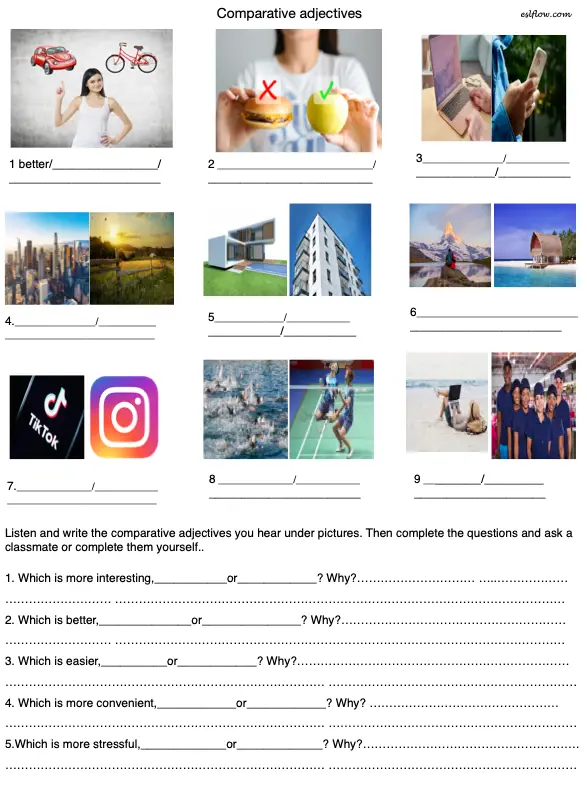Comparative Adjective Exercises and WorksheetsComparative adjectives conversation
19th December 2023
1 “as…as” and “not as”
Below are some exercises for practicing “as…as” and “not as” for making comparisons.
Exercises focusing on the grammar usage of “as..as” and “not as” (PDF)
Critical thinking exercises for practicing “as..as” and “not as” (PDF)
Conversational questions for practicing “as..as” and “not as” (PDF)
Subscribe to Eslflow
Subscribe to get full access to complete exercises with answers. In addition, you will receive the latest, and best resources from eslflow.com. There are no ads in the newsletter and you will receive entertaining, high quality, and up-to-date teaching resources regularly. And, if you subscribe, you will get access to advancements in artificial intelligence and prompt engineering, that will enable you to become a master of the English as a second language universe!
2 Comparative adjectives discussion
This is an exercise to help students use comparative adjectives.
3 Comparative adjectives conversation
In this exercise, students are required to complete a conversation using given phrases and their own ideas.
(see the YouTube video: visual cues)
(see the YouTube video: gap fill)
4 Comparative adjectives intro (using + er, y= ier, more..than)
This worksheet offers an introduction to basic comparative adjectives with: + er, y= ier, and more..than.
5 Comparative adjective chart exercise (with answers)
This is an elementary exercise to help students understand and remember the different forms of comparative adjectives. Students write in the appropriate adjectives to complete the chart.
Comparative adjective chart exercise (PDF)
5 Comparative adjective sorting exercise (with answers)
This is another elementary exercise challenging students’ understand ing of the different forms of comparative adjectives. Students fill in each column with the appropriate comparative adjective form.
Comparative adjective sorting exercise (PDF)
7 Writing sentences with comparative adjectives (with answers)
In this exercise, picture cues are used to suggest comparisons. Students use the adjectives at the side of the page or their own ideas to write sentences. Multiple adjectives might apply to each set of pictures and it would be possible to ask the students to write as many sentences as possible to describe the pictures.
Writing comparative adjective sentences (PDF)
Related Resources:
Reported speech and indirect requests
10 Adjectives Exercises Including Adjectives for People and Things
6 Picture-Based Present Continuous Worksheets (PDF)
8 Preposition Exercises for Location, Time and Movement (PDF)
5 Useful Passive Tense Practice worksheets
6 Present Perfect Language and Speaking Worksheets
7 Incredibly Useful Past Tense Simple Teaching Activities (PDF)
Great Exercises for the Conditionals (PDF)





